Special Report
This Is the City in Every State Where COVID-19 Is Growing the Fastest
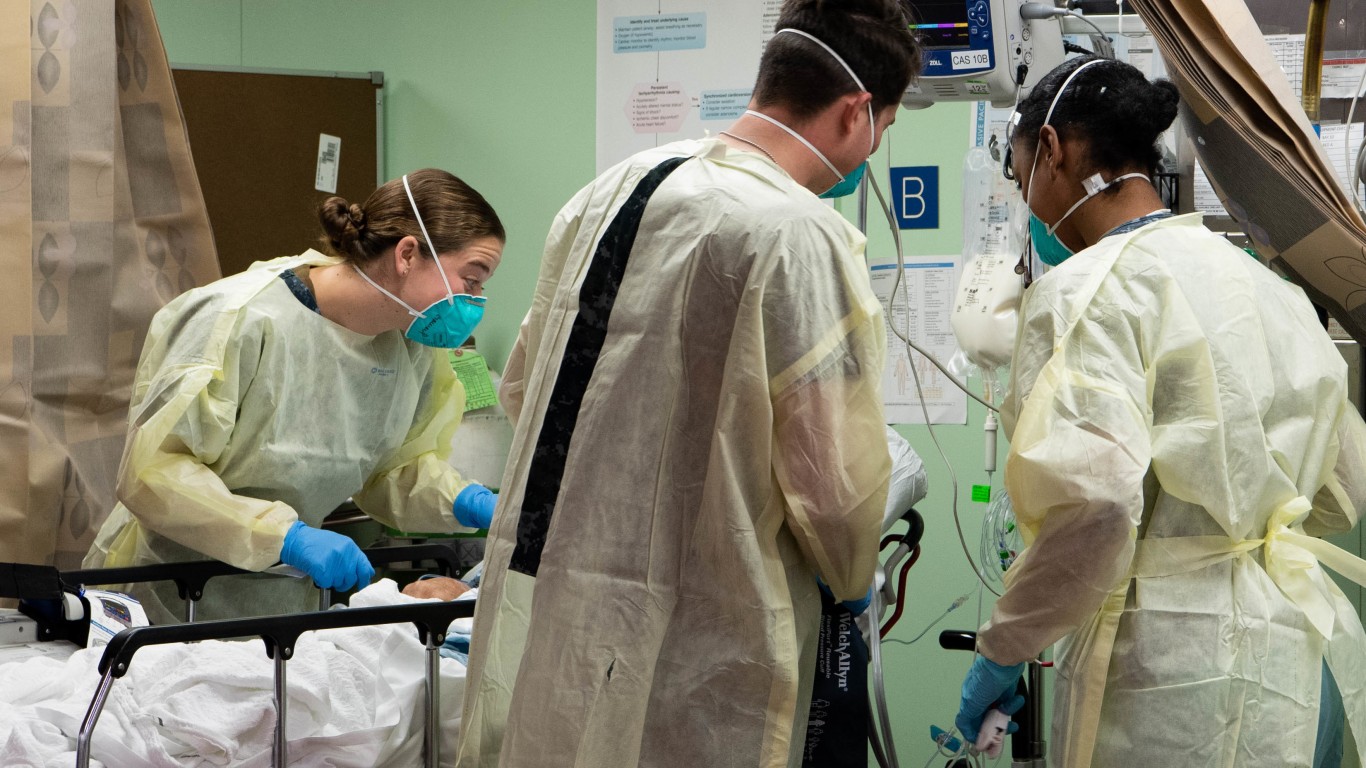
Published:
Last Updated:

The U.S. has reported more than 82.4 million confirmed COVID-19 cases as of May 24. There have been more than 994,000 reported deaths from COVID-19-related causes — the highest death toll of any country.
The extent of the spread of the novel coronavirus continues to vary considerably from state to state, and from city to city. Even as the number of daily new cases is flattening or even declining in some parts of the country, it is surging at a growing rate in others.
Nationwide, the number of new cases is growing at an increasing rate. There were an average of 30.4 daily new coronavirus cases per 100,000 Americans in the week ending May 24, an increase from the week prior, when there were an average of 24.3 daily new coronavirus cases per 100,000 people.
Metropolitan areas with a high degree of mobility and a large population may be particularly vulnerable to outbreaks. While science and medical professionals are still studying how exactly the virus spreads, experts agree that outbreaks are more likely to occur in group settings where large numbers of people routinely have close contact with one another. Cities with high concentrations of dense spaces such as colleges, correctional facilities, and nursing homes are particularly at risk.
The city with the highest seven-day average of new daily COVID-19 cases per capita is in Massachusetts. In the Pittsfield, MA, metro area, there were an average of 104.0 daily new coronavirus cases per 100,000 residents in the week ending May 24, the most of any U.S. metro area. Other cities where COVID-19 is growing the fastest include Hartford-East Hartford-Middletown, CT; New Haven-Milford, CT; and Ann Arbor, MI.
To determine the metropolitan area in each state where COVID-19 is growing the fastest, 24/7 Wall St. compiled and reviewed data from state and local health departments. We ranked metropolitan areas according to the average number of new daily COVID-19 cases per 100,000 residents in the seven days ending May 24. Data was aggregated from the county level to the metropolitan area level using boundary definitions from the U.S. Census Bureau. Population data used to adjust case and death totals came from the U.S. Census Bureau’s 2019 American Community Survey and are five-year estimates. Unemployment data is from the Bureau of Labor Statistics and is seasonally adjusted.

Alabama: Huntsville
Avg. new daily cases in Huntsville in week ending May 24: 16.2 per 100,000
Avg. new daily cases in Huntsville in week ending May 17: 10.6 per 100,000
COVID-19 cases in Huntsville as of May 24: 116,015 (25,386.0 per 100,000)
Peak pandemic unemployment in Huntsville: 11.4% (April 2020)
Huntsville population: 457,003 (335.7 people per sq. mi.)
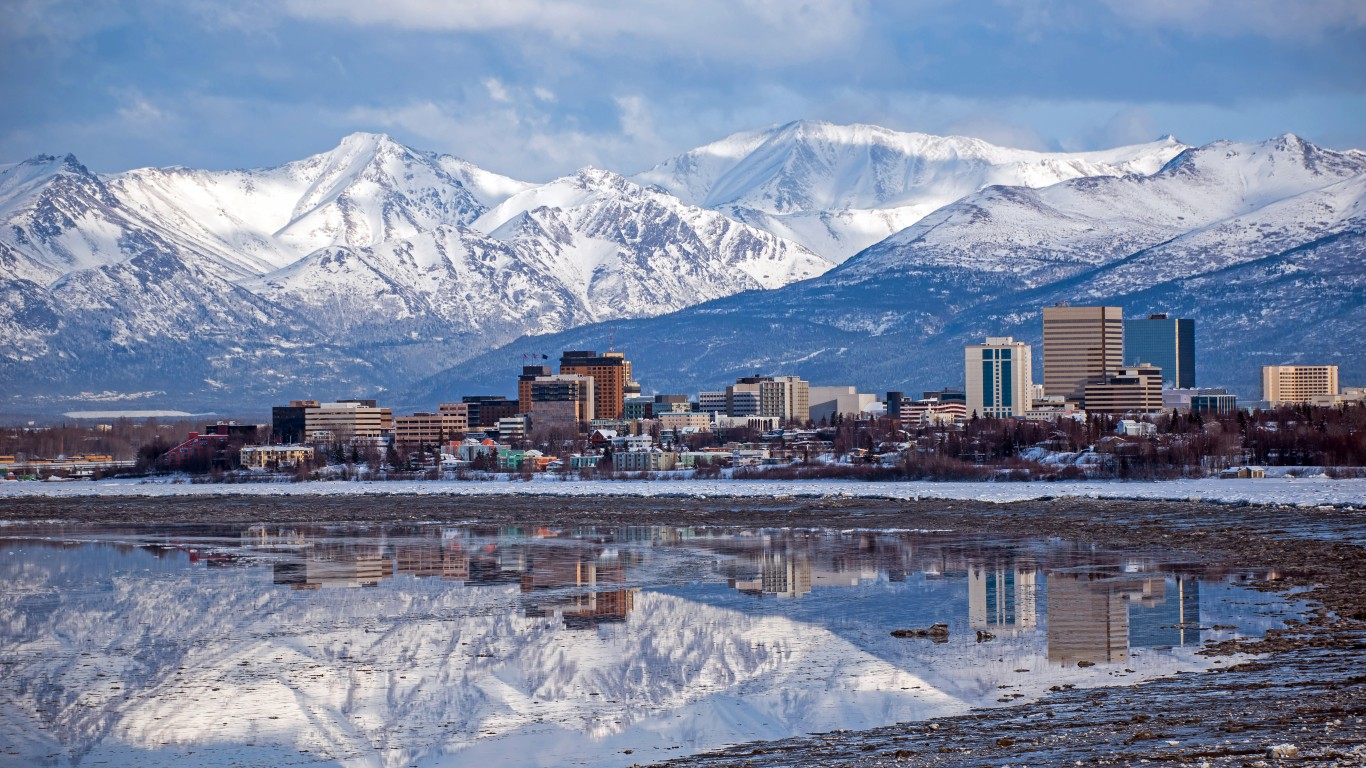
Alaska: Anchorage
Avg. new daily cases in Anchorage in week ending May 24: 29.3 per 100,000
Avg. new daily cases in Anchorage in week ending May 17: 28.0 per 100,000
COVID-19 cases in Anchorage as of May 24: 142,057 (35,612.2 per 100,000)
Peak pandemic unemployment in Anchorage: 14.8% (April 2020)
Anchorage population: 398,900 (15.2 people per sq. mi.)
These are all the counties in Alaska where COVID-19 is slowing (and where it’s still getting worse).

Arizona: Flagstaff
Avg. new daily cases in Flagstaff in week ending May 24: 17.0 per 100,000
Avg. new daily cases in Flagstaff in week ending May 17: 16.3 per 100,000
COVID-19 cases in Flagstaff as of May 24: 44,263 (31,331.3 per 100,000)
Peak pandemic unemployment in Flagstaff: 17.9% (April 2020)
Flagstaff population: 141,274 (7.6 people per sq. mi.)

Arkansas: Little Rock-North Little Rock-Conway
Avg. new daily cases in Little Rock in week ending May 24: 11.8 per 100,000
Avg. new daily cases in Little Rock in week ending May 17: 8.6 per 100,000
COVID-19 cases in Little Rock as of May 24: 198,028 (26,868.9 per 100,000)
Peak pandemic unemployment in Little Rock: 11.2% (April 2020)
Little Rock population: 737,015 (180.4 people per sq. mi.)
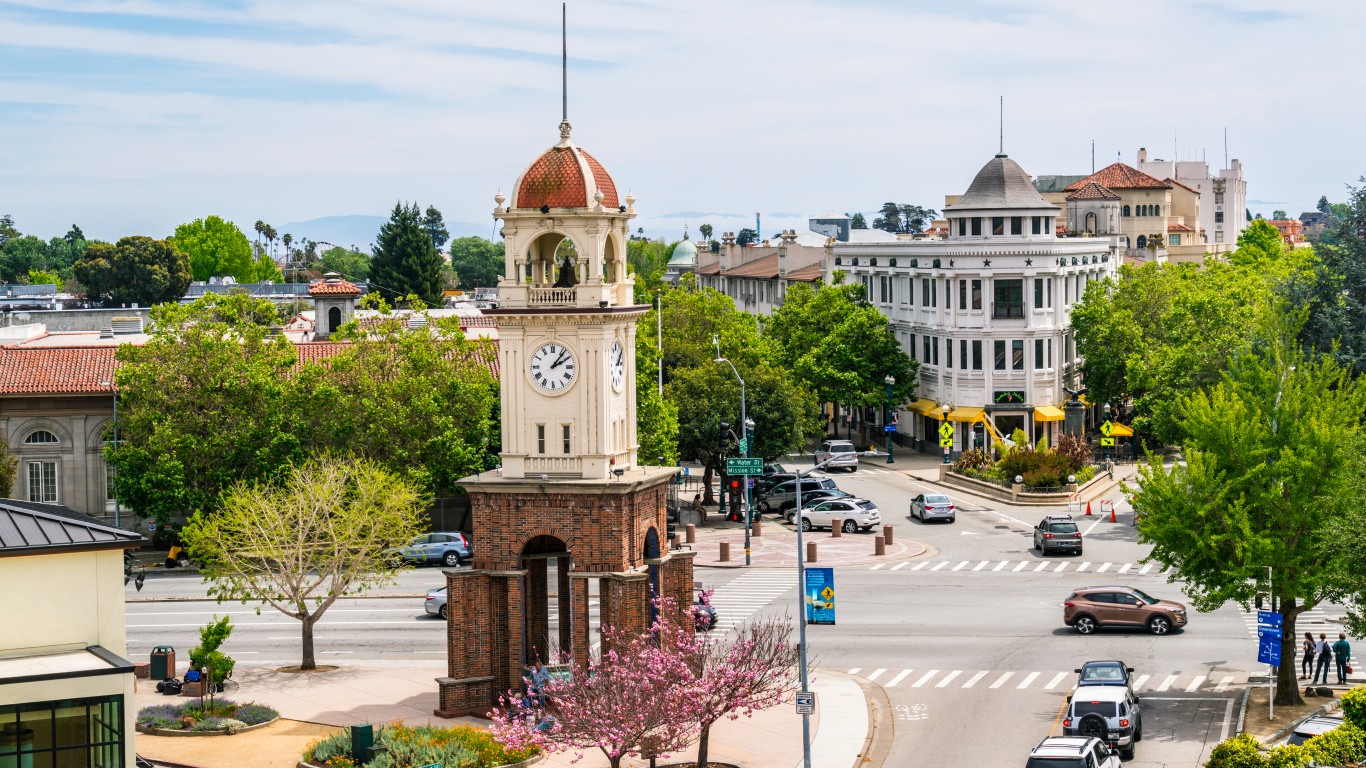
California: Santa Cruz-Watsonville
Avg. new daily cases in Santa Cruz in week ending May 24: 51.8 per 100,000
Avg. new daily cases in Santa Cruz in week ending May 17: 42.3 per 100,000
COVID-19 cases in Santa Cruz as of May 24: 53,668 (19,589.6 per 100,000)
Peak pandemic unemployment in Santa Cruz: 16.4% (April 2020)
Santa Cruz population: 273,962 (615.4 people per sq. mi.)

Colorado: Boulder
Avg. new daily cases in Boulder in week ending May 24: 64.6 per 100,000
Avg. new daily cases in Boulder in week ending May 17: 36.4 per 100,000
COVID-19 cases in Boulder as of May 24: 68,640 (21,283.1 per 100,000)
Peak pandemic unemployment in Boulder: 9.8% (April 2020)
Boulder population: 322,510 (444.1 people per sq. mi.)

Connecticut: Hartford-East Hartford-Middletown
Avg. new daily cases in Hartford in week ending May 24: 83.5 per 100,000
Avg. new daily cases in Hartford in week ending May 17: 50.0 per 100,000
COVID-19 cases in Hartford as of May 24: 246,028 (20,372.0 per 100,000)
Peak pandemic unemployment in Hartford: 9.9% (July 2020)
Hartford population: 1,207,677 (797.4 people per sq. mi.)

Delaware: Dover
Avg. new daily cases in Dover in week ending May 24: 61.2 per 100,000
Avg. new daily cases in Dover in week ending May 17: 35.9 per 100,000
COVID-19 cases in Dover as of May 24: 52,621 (29,780.0 per 100,000)
Peak pandemic unemployment in Dover: 17.3% (May 2020)
Dover population: 176,699 (301.4 people per sq. mi.)
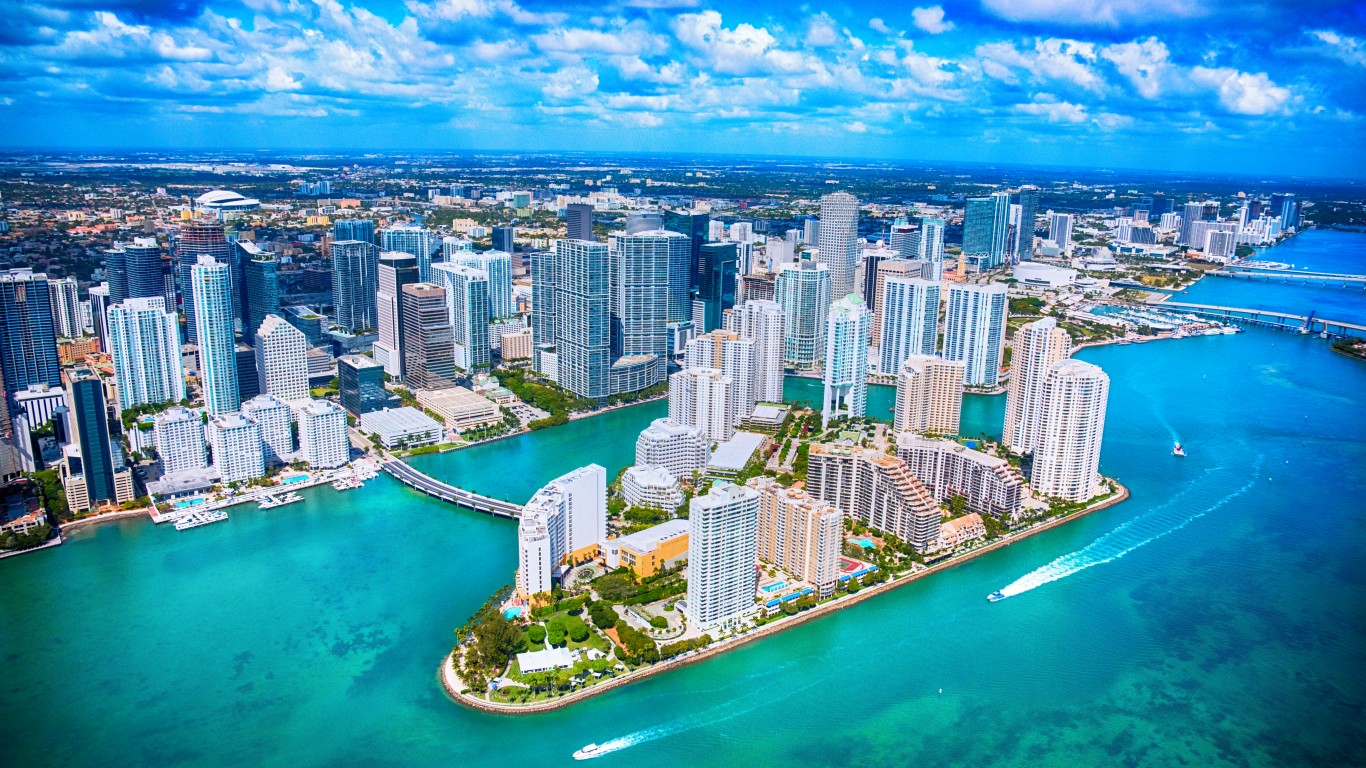
Florida: Miami-Fort Lauderdale-Pompano Beach
Avg. new daily cases in Miami in week ending May 24: 31.4 per 100,000
Avg. new daily cases in Miami in week ending May 17: 26.1 per 100,000
COVID-19 cases in Miami as of May 24: 2,258,420 (37,080.1 per 100,000)
Peak pandemic unemployment in Miami: 13.8% (April 2020)
Miami population: 6,090,660 (1,199.6 people per sq. mi.)
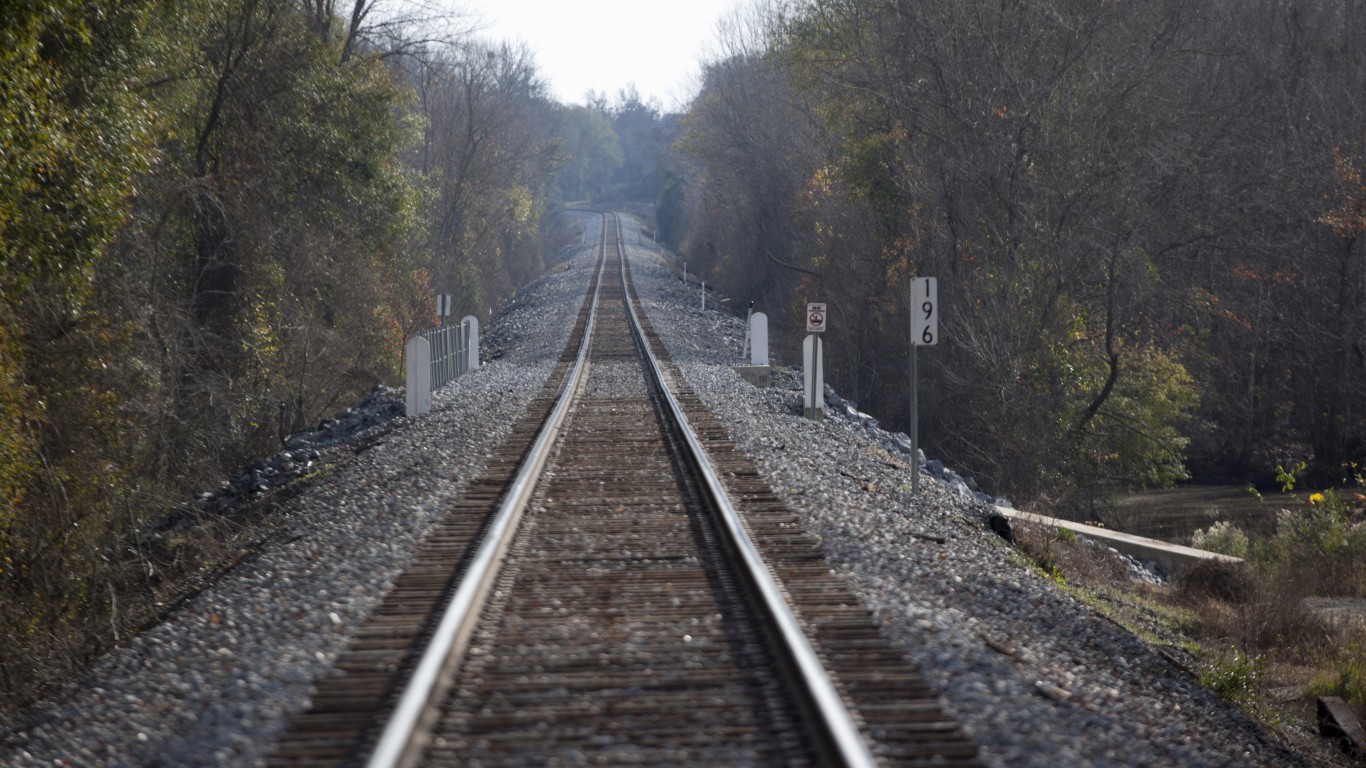
Georgia: Warner Robins
Avg. new daily cases in Warner Robins in week ending May 24: 19.8 per 100,000
Avg. new daily cases in Warner Robins in week ending May 17: 14.2 per 100,000
COVID-19 cases in Warner Robins as of May 24: 46,244 (25,598.4 per 100,000)
Peak pandemic unemployment in Warner Robins: 10.5% (April 2020)
Warner Robins population: 180,652 (343.6 people per sq. mi.)

Hawaii: Urban Honolulu
Avg. new daily cases in Urban Honolulu in week ending May 24: 67.0 per 100,000
Avg. new daily cases in Urban Honolulu in week ending May 17: 51.7 per 100,000
COVID-19 cases in Urban Honolulu as of May 24: 183,391 (18,621.8 per 100,000)
Peak pandemic unemployment in Urban Honolulu: 20.7% (April 2020)
Urban Honolulu population: 984,821 (1,639.3 people per sq. mi.)
These are all the counties in Hawaii where COVID-19 is slowing (and where it’s still getting worse).

Idaho: Boise City
Avg. new daily cases in Boise City in week ending May 24: 14.1 per 100,000
Avg. new daily cases in Boise City in week ending May 17: 11.7 per 100,000
COVID-19 cases in Boise City as of May 24: 204,795 (28,814.2 per 100,000)
Peak pandemic unemployment in Boise City: 12.6% (April 2020)
Boise City population: 710,743 (60.4 people per sq. mi.)
These are all the counties in Idaho where COVID-19 is slowing (and where it’s still getting worse).
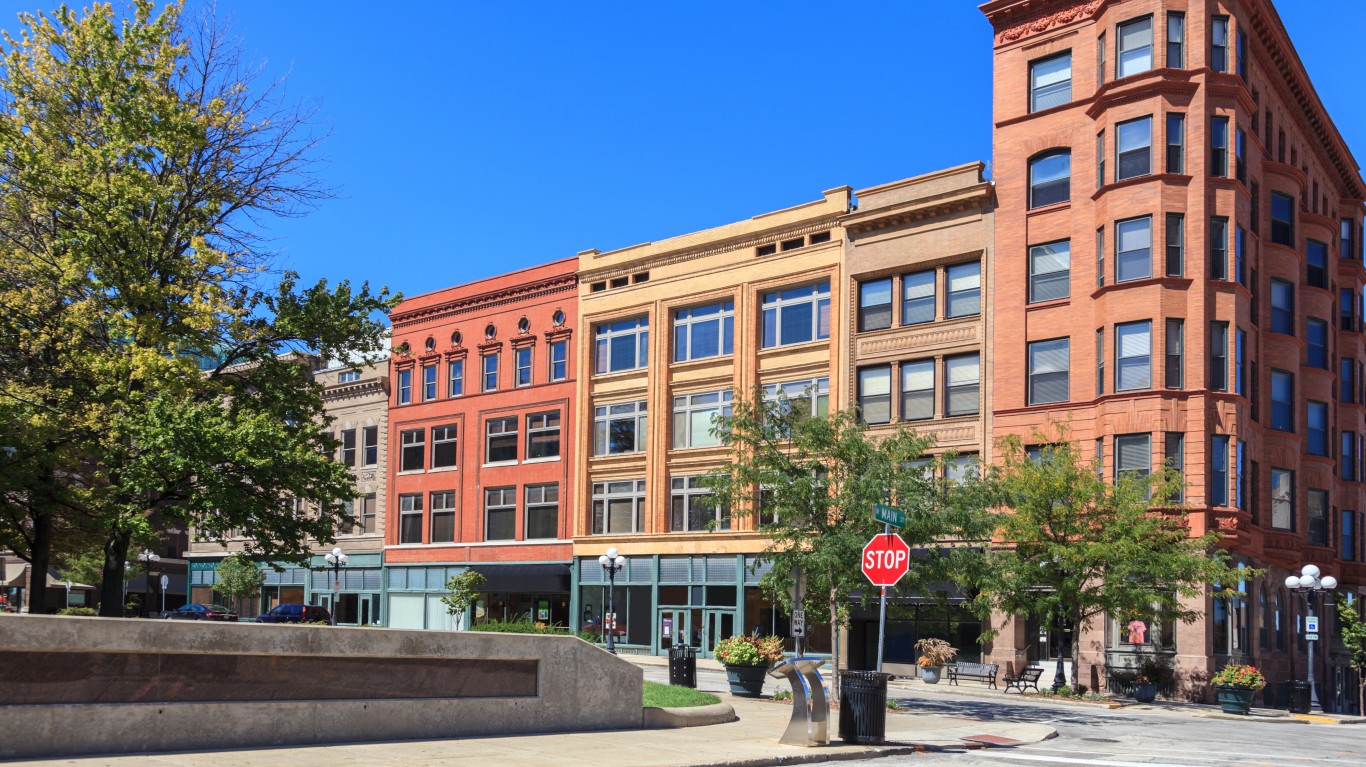
Illinois: Bloomington
Avg. new daily cases in Bloomington in week ending May 24: 57.0 per 100,000
Avg. new daily cases in Bloomington in week ending May 17: 52.0 per 100,000
COVID-19 cases in Bloomington as of May 24: 52,978 (30,698.0 per 100,000)
Peak pandemic unemployment in Bloomington: 14.0% (April 2020)
Bloomington population: 172,578 (145.8 people per sq. mi.)

Indiana: Bloomington
Avg. new daily cases in Bloomington in week ending May 24: 25.8 per 100,000
Avg. new daily cases in Bloomington in week ending May 17: 25.3 per 100,000
COVID-19 cases in Bloomington as of May 24: 35,048 (20,949.7 per 100,000)
Peak pandemic unemployment in Bloomington: 11.2% (April 2020)
Bloomington population: 167,296 (214.5 people per sq. mi.)
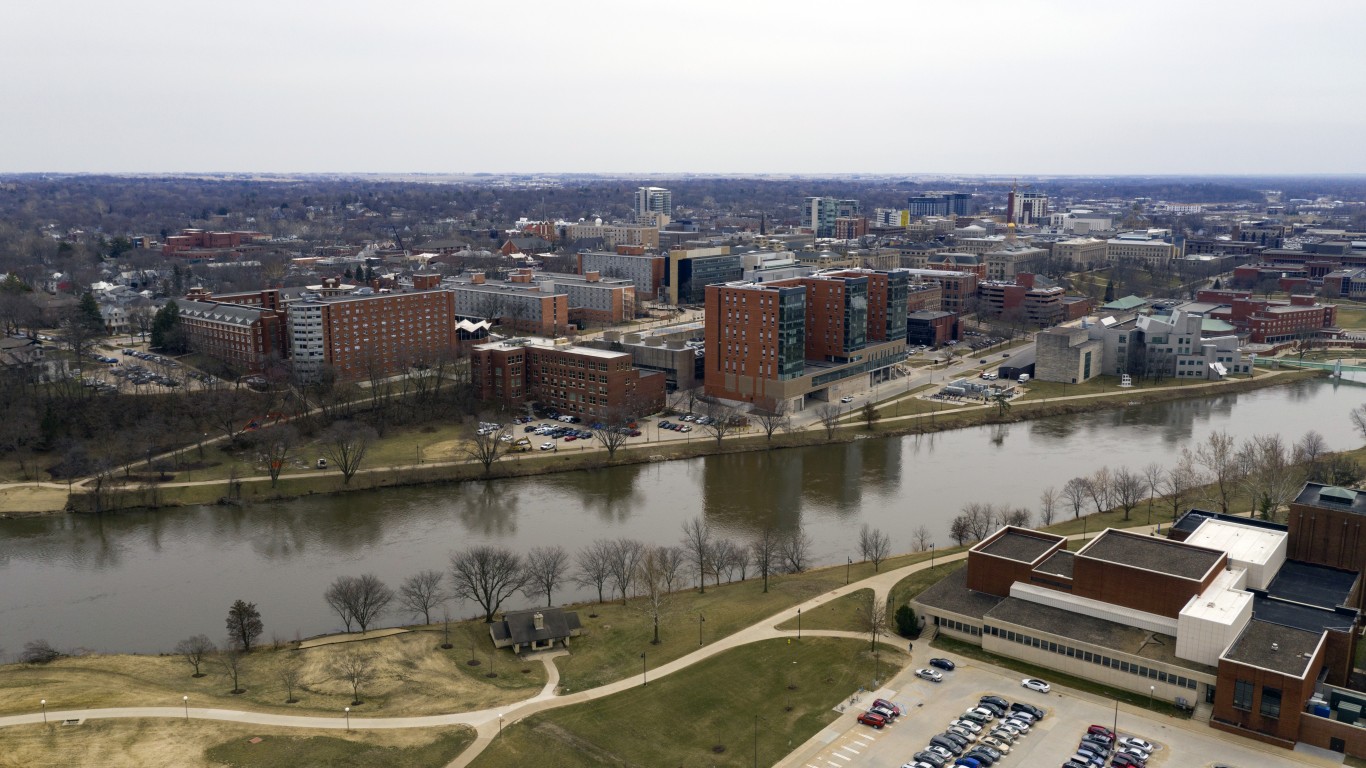
Iowa: Iowa City
Avg. new daily cases in Iowa City in week ending May 24: 50.9 per 100,000
Avg. new daily cases in Iowa City in week ending May 17: 40.1 per 100,000
COVID-19 cases in Iowa City as of May 24: 41,867 (24,530.0 per 100,000)
Peak pandemic unemployment in Iowa City: 10.1% (April 2020)
Iowa City population: 170,677 (144.3 people per sq. mi.)
These are all the counties in Iowa where COVID-19 is slowing (and where it’s still getting worse).
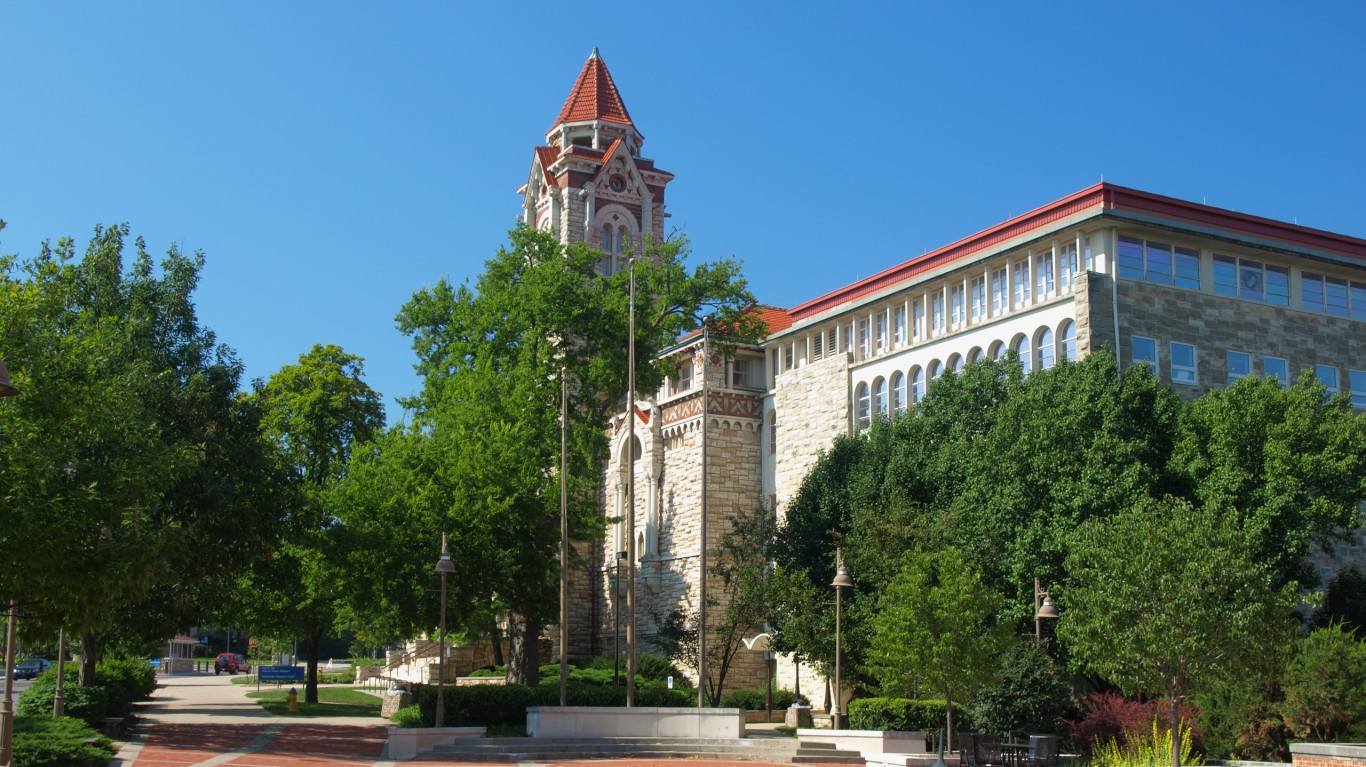
Kansas: Lawrence
Avg. new daily cases in Lawrence in week ending May 24: 36.0 per 100,000
Avg. new daily cases in Lawrence in week ending May 17: 39.2 per 100,000
COVID-19 cases in Lawrence as of May 24: 27,670 (23,002.7 per 100,000)
Peak pandemic unemployment in Lawrence: 12.1% (April 2020)
Lawrence population: 120,290 (263.9 people per sq. mi.)
These are all the counties in Kansas where COVID-19 is slowing (and where it’s still getting worse).
Kentucky: Louisville/Jefferson County, KY-IN
Avg. new daily cases in Louisville/Jefferson County in week ending May 24: 35.0 per 100,000
Avg. new daily cases in Louisville/Jefferson County in week ending May 17: 19.4 per 100,000
COVID-19 cases in Louisville/Jefferson County as of May 24: 364,183 (28,970.4 per 100,000)
Peak pandemic unemployment in Louisville/Jefferson County: 17.4% (April 2020)
Louisville/Jefferson County population: 1,257,088 (388.4 people per sq. mi.)

Louisiana: New Orleans-Metairie
Avg. new daily cases in New Orleans in week ending May 24: 27.8 per 100,000
Avg. new daily cases in New Orleans in week ending May 17: 18.4 per 100,000
COVID-19 cases in New Orleans as of May 24: 314,133 (24,778.3 per 100,000)
Peak pandemic unemployment in New Orleans: 20.0% (April 2020)
New Orleans population: 1,267,777 (396.0 people per sq. mi.)

Maine: Portland-South Portland
Avg. new daily cases in Portland in week ending May 24: 52.8 per 100,000
Avg. new daily cases in Portland in week ending May 17: 56.9 per 100,000
COVID-19 cases in Portland as of May 24: 102,536 (19,271.0 per 100,000)
Peak pandemic unemployment in Portland: 10.9% (April 2020)
Portland population: 532,075 (255.8 people per sq. mi.)
These are all the counties in Maine where COVID-19 is slowing (and where it’s still getting worse).
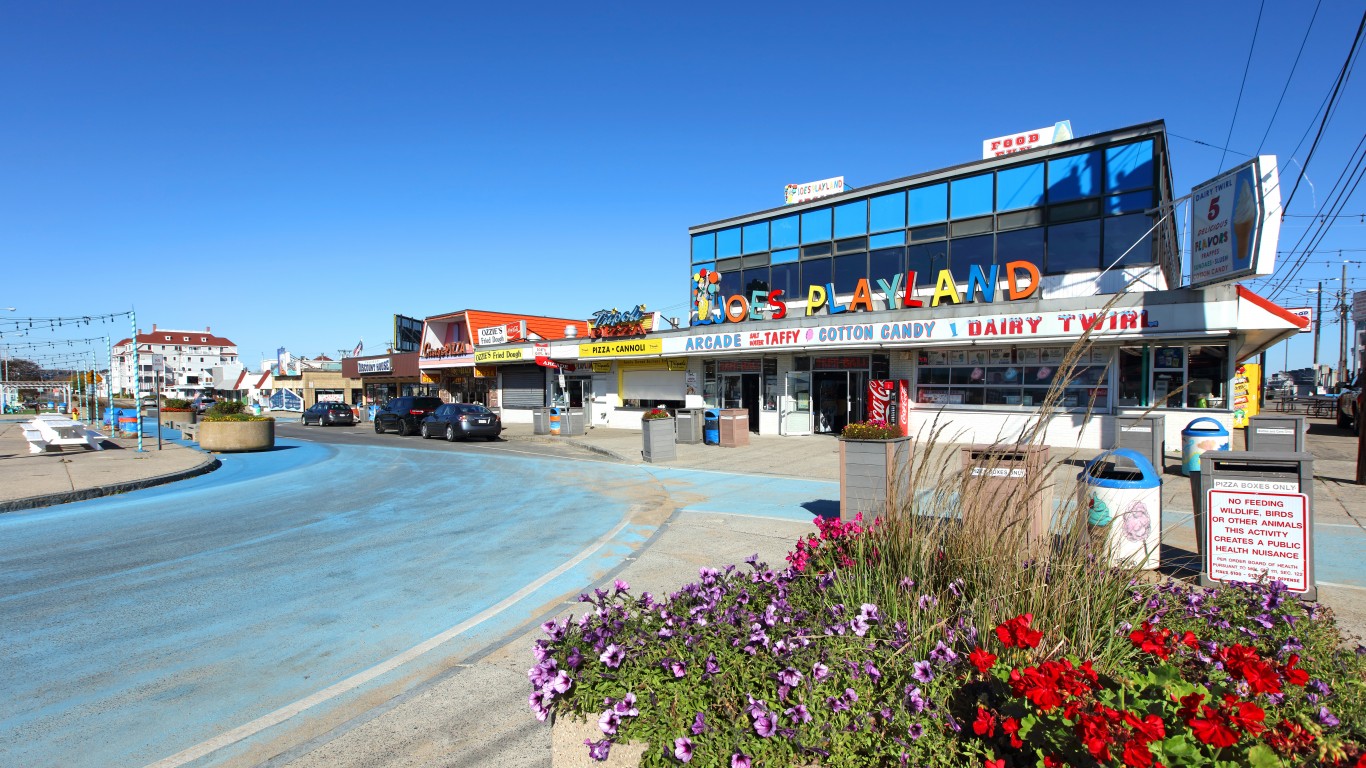
Maryland: Salisbury, MD-DE
Avg. new daily cases in Salisbury in week ending May 24: 38.0 per 100,000
Avg. new daily cases in Salisbury in week ending May 17: 27.3 per 100,000
COVID-19 cases in Salisbury as of May 24: 98,378 (24,325.9 per 100,000)
Peak pandemic unemployment in Salisbury: 16.0% (April 2020)
Salisbury population: 404,417 (192.7 people per sq. mi.)
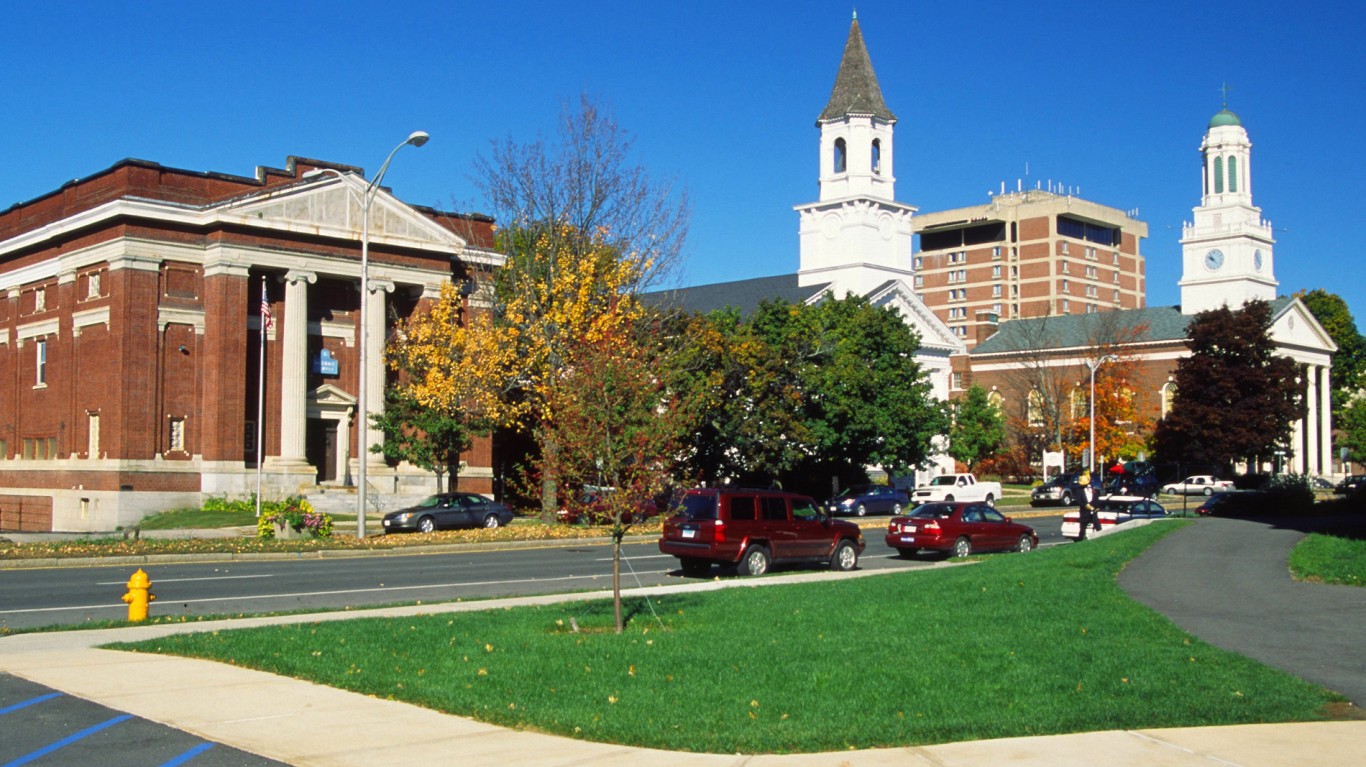
Massachusetts: Pittsfield
Avg. new daily cases in Pittsfield in week ending May 24: 104.0 per 100,000
Avg. new daily cases in Pittsfield in week ending May 17: 99.8 per 100,000
COVID-19 cases in Pittsfield as of May 24: 27,033 (21,382.6 per 100,000)
Peak pandemic unemployment in Pittsfield: 18.3% (June 2020)
Pittsfield population: 126,425 (136.4 people per sq. mi.)
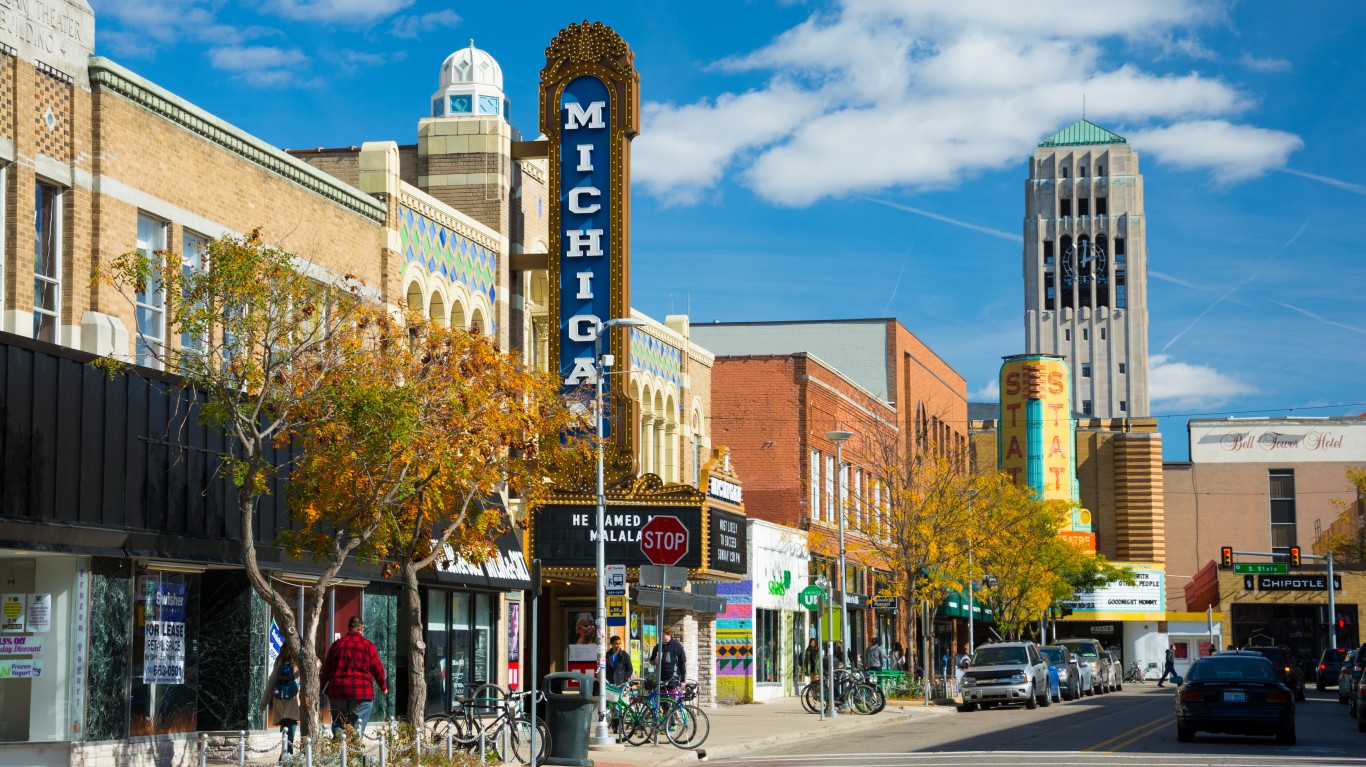
Michigan: Ann Arbor
Avg. new daily cases in Ann Arbor in week ending May 24: 72.6 per 100,000
Avg. new daily cases in Ann Arbor in week ending May 17: 69.6 per 100,000
COVID-19 cases in Ann Arbor as of May 24: 83,922 (22,867.0 per 100,000)
Peak pandemic unemployment in Ann Arbor: 15.5% (April 2020)
Ann Arbor population: 367,000 (519.9 people per sq. mi.)

Minnesota: Duluth, MN-WI
Avg. new daily cases in Duluth in week ending May 24: 53.4 per 100,000
Avg. new daily cases in Duluth in week ending May 17: 40.5 per 100,000
COVID-19 cases in Duluth as of May 24: 72,972 (25,228.3 per 100,000)
Peak pandemic unemployment in Duluth: 12.9% (May 2020)
Duluth population: 289,247 (27.5 people per sq. mi.)

Mississippi: Jackson
Avg. new daily cases in Jackson in week ending May 24: 15.3 per 100,000
Avg. new daily cases in Jackson in week ending May 17: 10.2 per 100,000
COVID-19 cases in Jackson as of May 24: 141,073 (23,601.6 per 100,000)
Peak pandemic unemployment in Jackson: 15.0% (April 2020)
Jackson population: 597,727 (110.6 people per sq. mi.)

Missouri: St. Louis, MO-IL
Avg. new daily cases in St. Louis in week ending May 24: 26.6 per 100,000
Avg. new daily cases in St. Louis in week ending May 17: 20.3 per 100,000
COVID-19 cases in St. Louis as of May 24: 673,975 (24,026.0 per 100,000)
Peak pandemic unemployment in St. Louis: 11.6% (April 2020)
St. Louis population: 2,805,190 (356.7 people per sq. mi.)
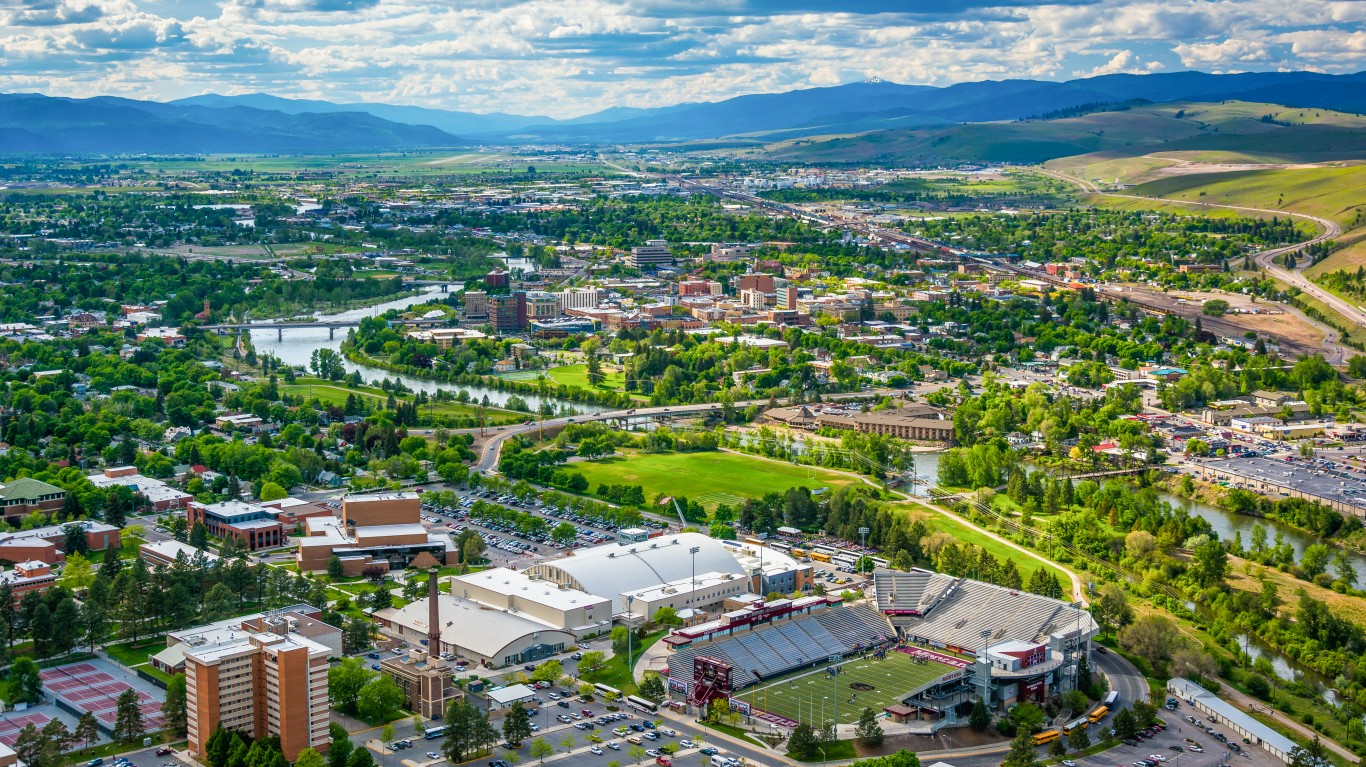
Montana: Missoula
Avg. new daily cases in Missoula in week ending May 24: 19.9 per 100,000
Avg. new daily cases in Missoula in week ending May 17: 13.3 per 100,000
COVID-19 cases in Missoula as of May 24: 27,857 (23,746.7 per 100,000)
Peak pandemic unemployment in Missoula: 13.3% (April 2020)
Missoula population: 117,309 (45.2 people per sq. mi.)

Nebraska: Lincoln
Avg. new daily cases in Lincoln in week ending May 24: 21.6 per 100,000
Avg. new daily cases in Lincoln in week ending May 17: 2.9 per 100,000
COVID-19 cases in Lincoln as of May 24: 82,494 (24,973.3 per 100,000)
Peak pandemic unemployment in Lincoln: 9.6% (April 2020)
Lincoln population: 330,329 (234.4 people per sq. mi.)

Nevada: Las Vegas-Henderson-Paradise
Avg. new daily cases in Las Vegas in week ending May 24: 21.1 per 100,000
Avg. new daily cases in Las Vegas in week ending May 17: 15.4 per 100,000
COVID-19 cases in Las Vegas as of May 24: 547,316 (25,083.2 per 100,000)
Peak pandemic unemployment in Las Vegas: 34.2% (April 2020)
Las Vegas population: 2,182,004 (276.5 people per sq. mi.)
These are all the counties in Nevada where COVID-19 is slowing (and where it’s still getting worse).

New Hampshire: Manchester-Nashua
Avg. new daily cases in Manchester in week ending May 24: 43.6 per 100,000
Avg. new daily cases in Manchester in week ending May 17: 40.3 per 100,000
COVID-19 cases in Manchester as of May 24: 102,969 (24,929.8 per 100,000)
Peak pandemic unemployment in Manchester: 17.5% (April 2020)
Manchester population: 413,035 (471.4 people per sq. mi.)

New Jersey: Trenton-Princeton
Avg. new daily cases in Trenton in week ending May 24: 59.0 per 100,000
Avg. new daily cases in Trenton in week ending May 17: 44.1 per 100,000
COVID-19 cases in Trenton as of May 24: 82,865 (22,522.4 per 100,000)
Peak pandemic unemployment in Trenton: 12.4% (June 2020)
Trenton population: 367,922 (1,638.4 people per sq. mi.)

New Mexico: Santa Fe
Avg. new daily cases in Santa Fe in week ending May 24: 37.9 per 100,000
Avg. new daily cases in Santa Fe in week ending May 17: 23.4 per 100,000
COVID-19 cases in Santa Fe as of May 24: 29,655 (19,863.6 per 100,000)
Peak pandemic unemployment in Santa Fe: 13.2% (July 2020)
Santa Fe population: 149,293 (78.2 people per sq. mi.)

New York: Glens Falls
Avg. new daily cases in Glens Falls in week ending May 24: 63.7 per 100,000
Avg. new daily cases in Glens Falls in week ending May 17: 62.6 per 100,000
COVID-19 cases in Glens Falls as of May 24: 28,363 (22,529.6 per 100,000)
Peak pandemic unemployment in Glens Falls: 15.8% (April 2020)
Glens Falls population: 125,892 (74.1 people per sq. mi.)

North Carolina: Raleigh-Cary
Avg. new daily cases in Raleigh in week ending May 24: 59.2 per 100,000
Avg. new daily cases in Raleigh in week ending May 17: 41.6 per 100,000
COVID-19 cases in Raleigh as of May 24: 387,520 (29,086.3 per 100,000)
Peak pandemic unemployment in Raleigh: 11.7% (May 2020)
Raleigh population: 1,332,311 (629.0 people per sq. mi.)
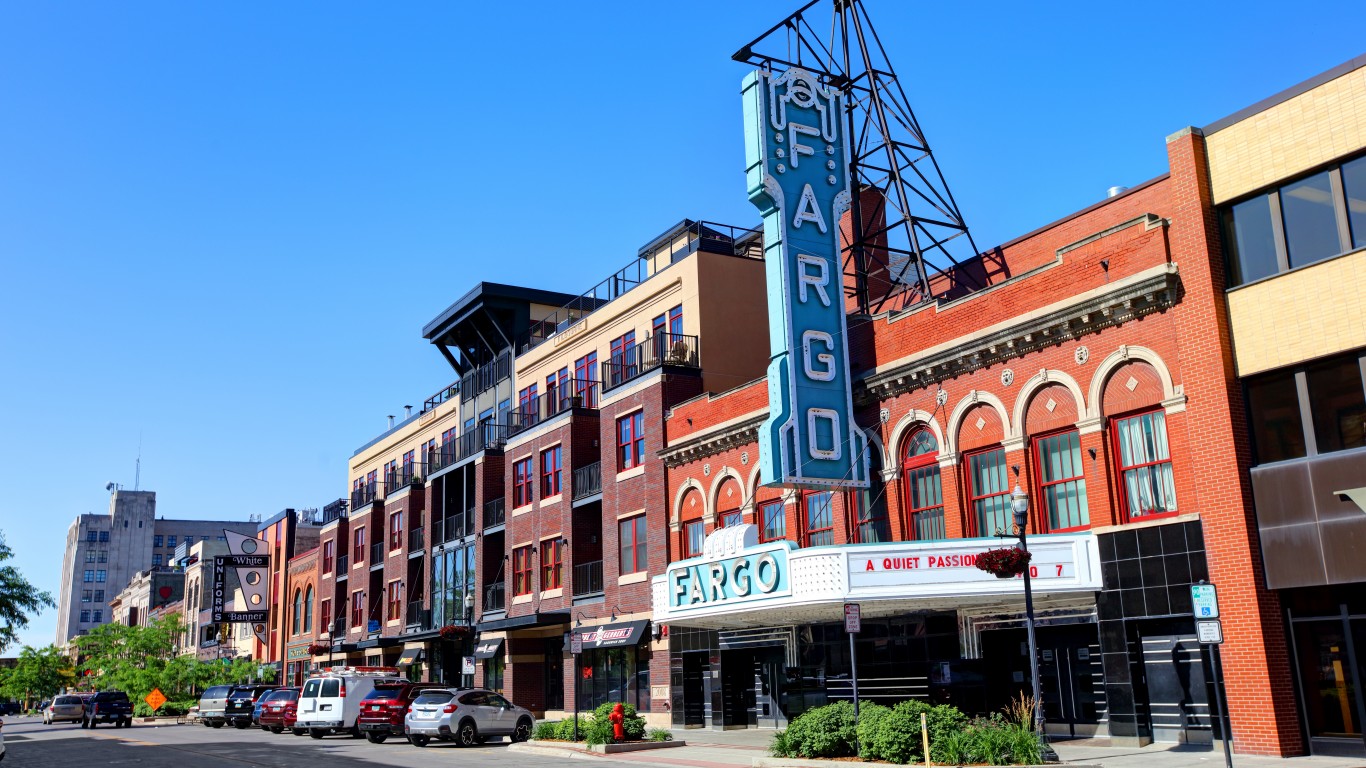
North Dakota: Fargo, ND-MN
Avg. new daily cases in Fargo in week ending May 24: 24.3 per 100,000
Avg. new daily cases in Fargo in week ending May 17: 23.5 per 100,000
COVID-19 cases in Fargo as of May 24: 80,540 (33,499.6 per 100,000)
Peak pandemic unemployment in Fargo: 7.7% (April 2020)
Fargo population: 240,421 (85.5 people per sq. mi.)

Ohio: Akron
Avg. new daily cases in Akron in week ending May 24: 29.5 per 100,000
Avg. new daily cases in Akron in week ending May 17: 22.1 per 100,000
COVID-19 cases in Akron as of May 24: 151,712 (21,554.7 per 100,000)
Peak pandemic unemployment in Akron: 16.2% (April 2020)
Akron population: 703,845 (781.9 people per sq. mi.)
These are all the counties in Ohio where COVID-19 is slowing (and where it’s still getting worse).

Oklahoma: Oklahoma City
Avg. new daily cases in Oklahoma City in week ending May 24: 10.3 per 100,000
Avg. new daily cases in Oklahoma City in week ending May 17: 6.6 per 100,000
COVID-19 cases in Oklahoma City as of May 24: 364,956 (26,391.8 per 100,000)
Peak pandemic unemployment in Oklahoma City: 15.2% (April 2020)
Oklahoma City population: 1,382,841 (250.9 people per sq. mi.)

Oregon: Bend
Avg. new daily cases in Bend in week ending May 24: 54.8 per 100,000
Avg. new daily cases in Bend in week ending May 17: 42.7 per 100,000
COVID-19 cases in Bend as of May 24: 48,685 (26,139.5 per 100,000)
Peak pandemic unemployment in Bend: 18.3% (April 2020)
Bend population: 186,251 (61.7 people per sq. mi.)
These are all the counties in Oregon where COVID-19 is slowing (and where it’s still getting worse).

Pennsylvania: Scranton–Wilkes-Barre
Avg. new daily cases in Scranton in week ending May 24: 42.4 per 100,000
Avg. new daily cases in Scranton in week ending May 17: 28.7 per 100,000
COVID-19 cases in Scranton as of May 24: 127,499 (22,946.3 per 100,000)
Peak pandemic unemployment in Scranton: 18.4% (April 2020)
Scranton population: 555,642 (318.1 people per sq. mi.)

Rhode Island: Providence-Warwick, RI-MA
Avg. new daily cases in Providence in week ending May 24: 53.7 per 100,000
Avg. new daily cases in Providence in week ending May 17: 46.5 per 100,000
COVID-19 cases in Providence as of May 24: 510,928 (31,572.5 per 100,000)
Peak pandemic unemployment in Providence: 18.5% (April 2020)
Providence population: 1,618,268 (1,019.8 people per sq. mi.)

South Carolina: Myrtle Beach-Conway-North Myrtle Beach, SC-NC
Avg. new daily cases in Myrtle Beach in week ending May 24: 31.4 per 100,000
Avg. new daily cases in Myrtle Beach in week ending May 17: 19.9 per 100,000
COVID-19 cases in Myrtle Beach as of May 24: 129,072 (27,818.0 per 100,000)
Peak pandemic unemployment in Myrtle Beach: 22.0% (April 2020)
Myrtle Beach population: 463,987 (234.2 people per sq. mi.)
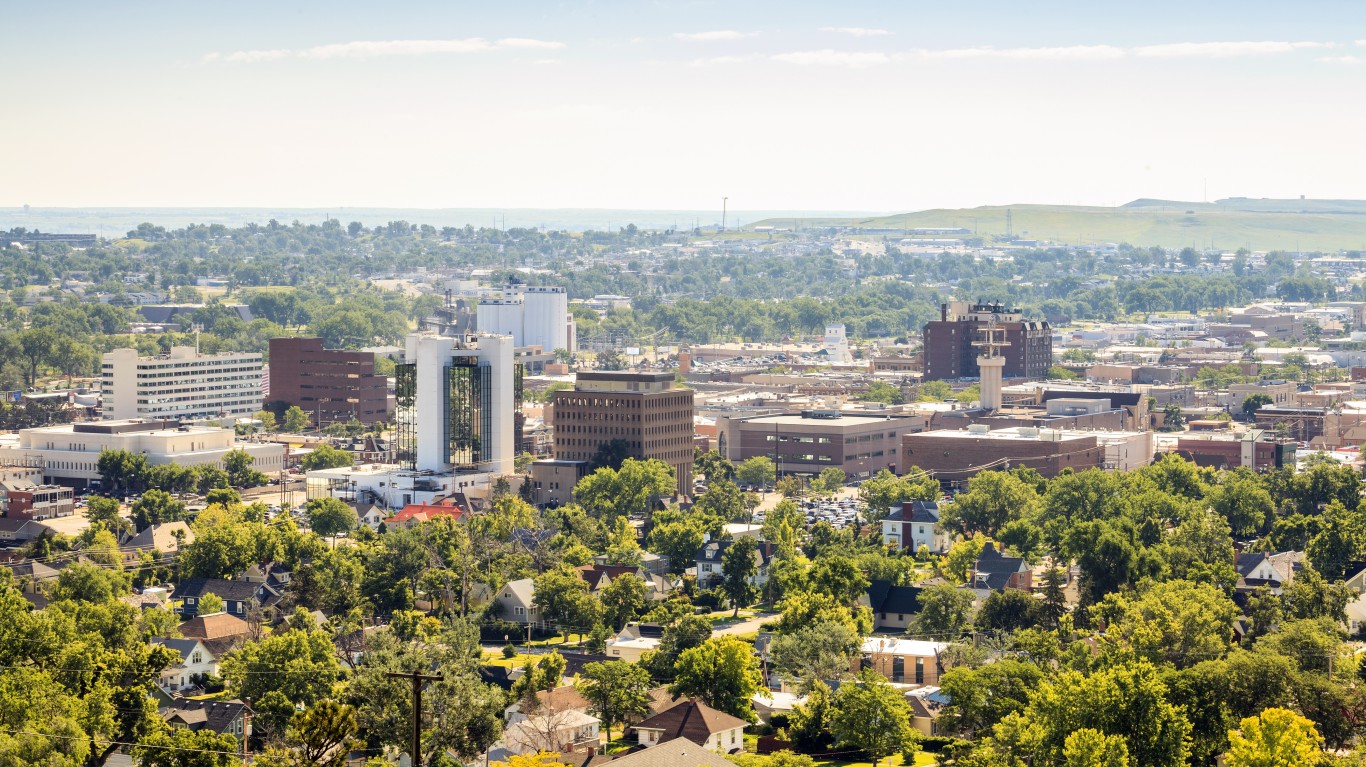
South Dakota: Rapid City
Avg. new daily cases in Rapid City in week ending May 24: 8.9 per 100,000
Avg. new daily cases in Rapid City in week ending May 17: 7.3 per 100,000
COVID-19 cases in Rapid City as of May 24: 40,035 (28,926.6 per 100,000)
Peak pandemic unemployment in Rapid City: 13.8% (April 2020)
Rapid City population: 138,402 (22.2 people per sq. mi.)

Tennessee: Memphis, TN-MS-AR
Avg. new daily cases in Memphis in week ending May 24: 20.2 per 100,000
Avg. new daily cases in Memphis in week ending May 17: 11.3 per 100,000
COVID-19 cases in Memphis as of May 24: 353,416 (26,381.8 per 100,000)
Peak pandemic unemployment in Memphis: 13.4% (April 2020)
Memphis population: 1,339,623 (292.6 people per sq. mi.)
Texas: Brownsville-Harlingen
Avg. new daily cases in Brownsville in week ending May 24: 25.9 per 100,000
Avg. new daily cases in Brownsville in week ending May 17: 21.2 per 100,000
COVID-19 cases in Brownsville as of May 24: 106,034 (25,146.4 per 100,000)
Peak pandemic unemployment in Brownsville: 17.6% (April 2020)
Brownsville population: 421,666 (473.3 people per sq. mi.)
These are all the counties in Texas where COVID-19 is slowing (and where it’s still getting worse).

Utah: Salt Lake City
Avg. new daily cases in Salt Lake City in week ending May 24: 23.4 per 100,000
Avg. new daily cases in Salt Lake City in week ending May 17: 20.9 per 100,000
COVID-19 cases in Salt Lake City as of May 24: 370,828 (30,875.5 per 100,000)
Peak pandemic unemployment in Salt Lake City: 11.3% (April 2020)
Salt Lake City population: 1,201,043 (156.3 people per sq. mi.)
These are all the counties in Utah where COVID-19 is slowing (and where it’s still getting worse).

Vermont: Burlington-South Burlington
Avg. new daily cases in Burlington in week ending May 24: 42.1 per 100,000
Avg. new daily cases in Burlington in week ending May 17: 49.0 per 100,000
COVID-19 cases in Burlington as of May 24: 46,505 (21,256.1 per 100,000)
Peak pandemic unemployment in Burlington: 14.8% (April 2020)
Burlington population: 218,784 (174.7 people per sq. mi.)
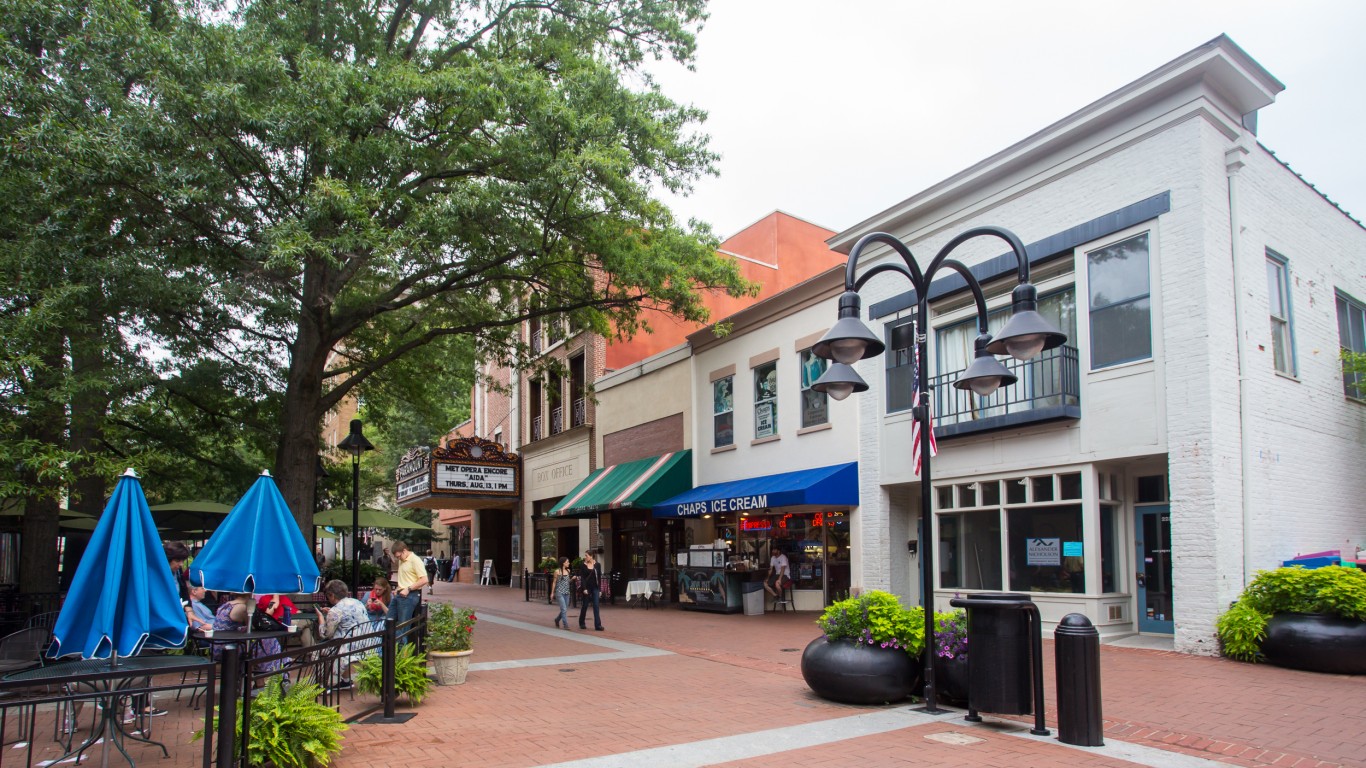
Virginia: Charlottesville
Avg. new daily cases in Charlottesville in week ending May 24: 49.6 per 100,000
Avg. new daily cases in Charlottesville in week ending May 17: 41.3 per 100,000
COVID-19 cases in Charlottesville as of May 24: 40,812 (18,943.1 per 100,000)
Peak pandemic unemployment in Charlottesville: 10.2% (April 2020)
Charlottesville population: 215,445 (131.0 people per sq. mi.)
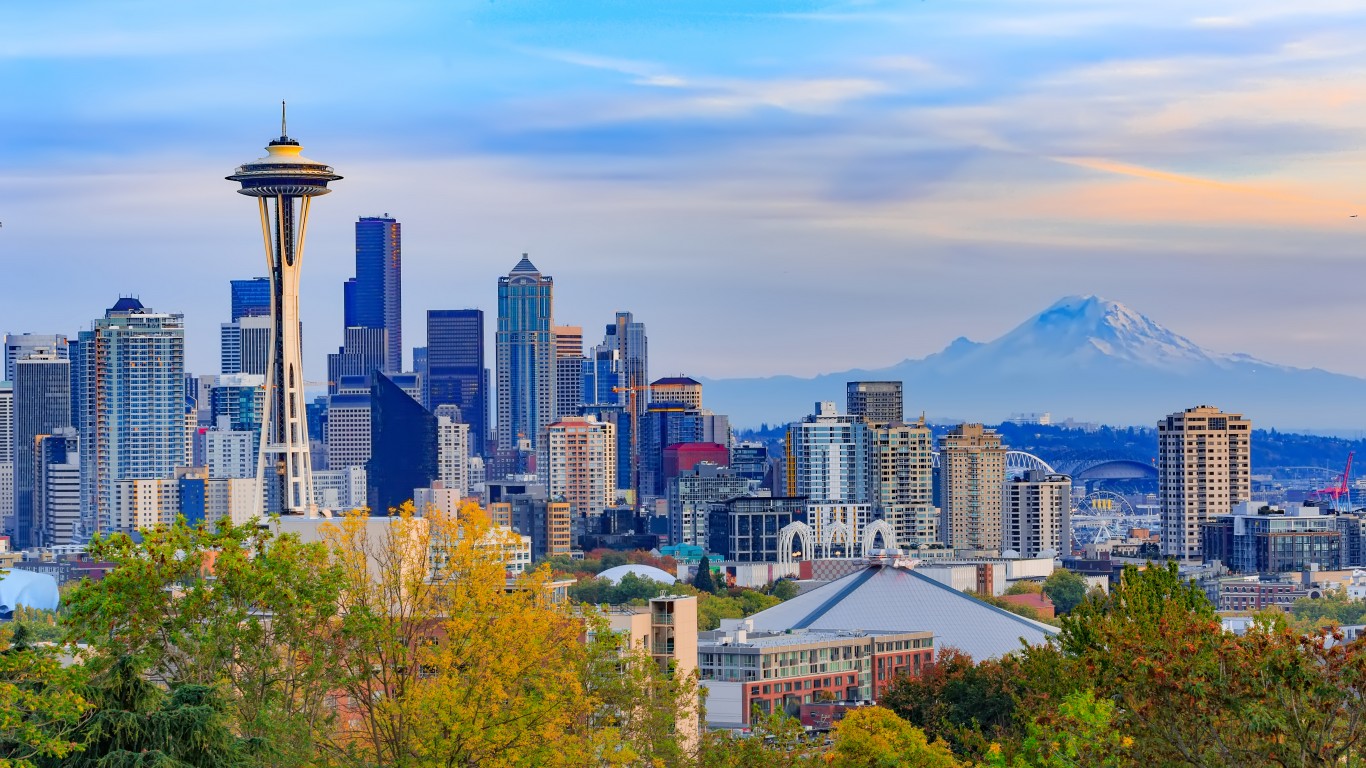
Washington: Seattle-Tacoma-Bellevue
Avg. new daily cases in Seattle in week ending May 24: 50.1 per 100,000
Avg. new daily cases in Seattle in week ending May 17: 37.7 per 100,000
COVID-19 cases in Seattle as of May 24: 782,157 (20,203.9 per 100,000)
Peak pandemic unemployment in Seattle: 17.3% (April 2020)
Seattle population: 3,871,323 (659.2 people per sq. mi.)

West Virginia: Beckley
Avg. new daily cases in Beckley in week ending May 24: 37.5 per 100,000
Avg. new daily cases in Beckley in week ending May 17: 23.6 per 100,000
COVID-19 cases in Beckley as of May 24: 36,676 (30,864.8 per 100,000)
Peak pandemic unemployment in Beckley: 18.4% (April 2020)
Beckley population: 118,828 (93.8 people per sq. mi.)
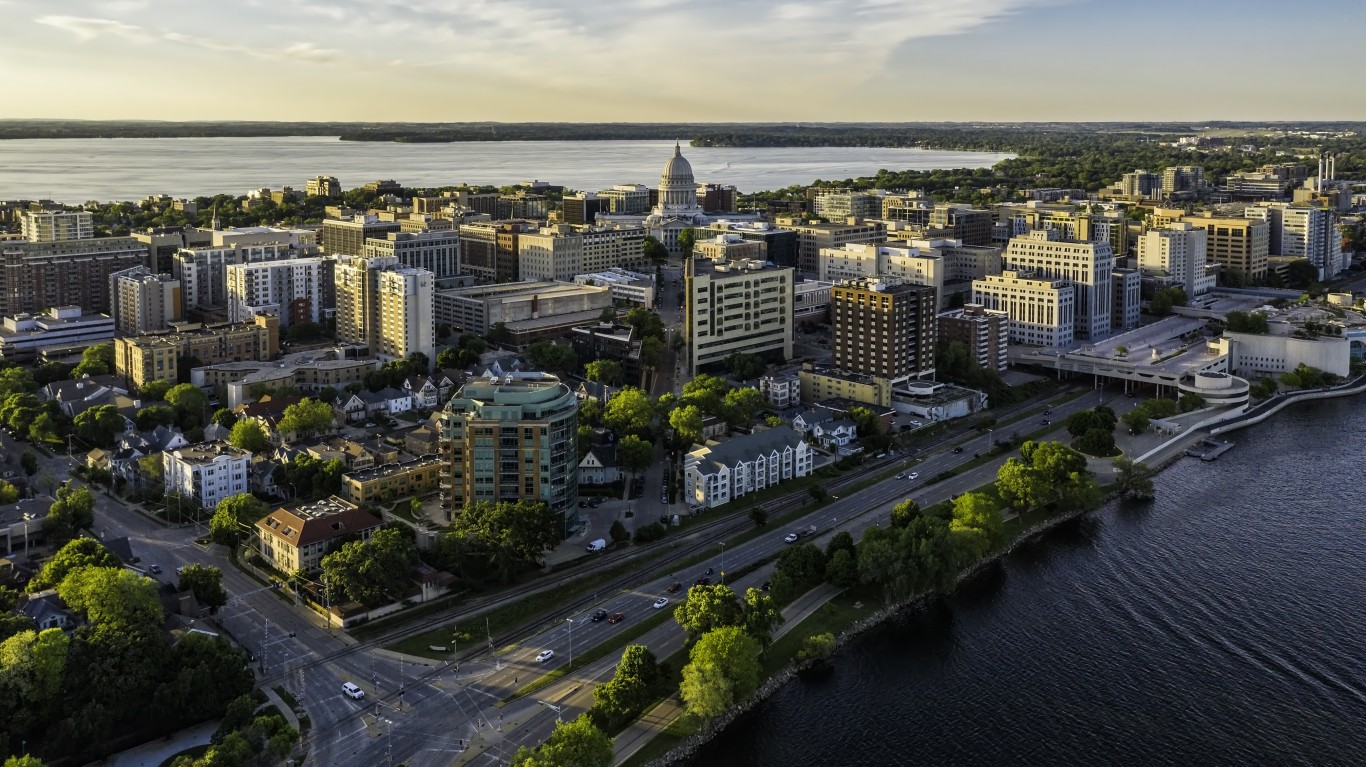
Wisconsin: Madison
Avg. new daily cases in Madison in week ending May 24: 64.2 per 100,000
Avg. new daily cases in Madison in week ending May 17: 66.1 per 100,000
COVID-19 cases in Madison as of May 24: 168,150 (25,721.8 per 100,000)
Peak pandemic unemployment in Madison: 11.6% (April 2020)
Madison population: 653,725 (197.5 people per sq. mi.)
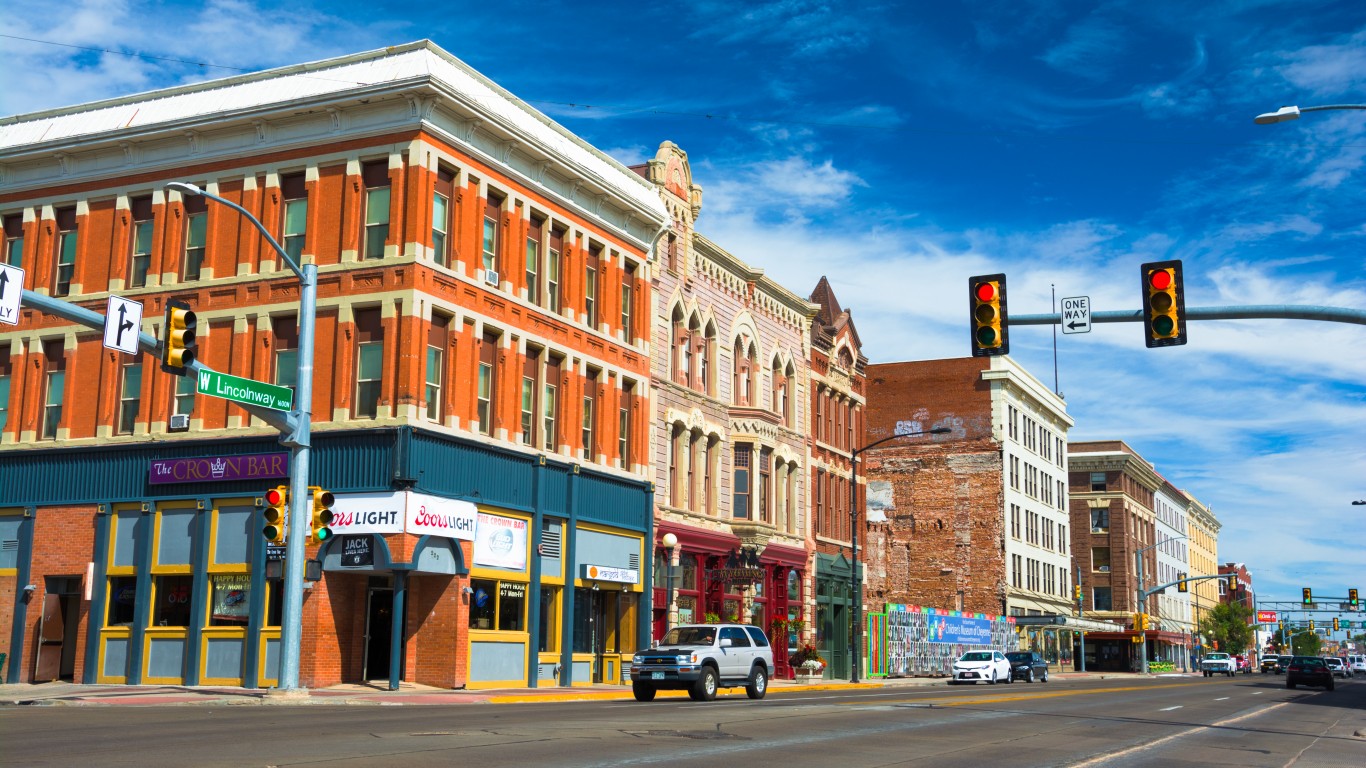
Wyoming: Cheyenne
Avg. new daily cases in Cheyenne in week ending May 24: 12.9 per 100,000
Avg. new daily cases in Cheyenne in week ending May 17: 11.2 per 100,000
COVID-19 cases in Cheyenne as of May 24: 26,382 (26,832.8 per 100,000)
Peak pandemic unemployment in Cheyenne: 9.2% (April 2020)
Cheyenne population: 98,320 (36.6 people per sq. mi.)
Click here to see all coronavirus data for every state.
Credit card companies are at war. The biggest issuers are handing out free rewards and benefits to win the best customers.
It’s possible to find cards paying unlimited 1.5%, 2%, and even more today. That’s free money for qualified borrowers, and the type of thing that would be crazy to pass up. Those rewards can add up to thousands of dollars every year in free money, and include other benefits as well.
We’ve assembled some of the best credit cards for users today. Don’t miss these offers because they won’t be this good forever.
Flywheel Publishing has partnered with CardRatings for our coverage of credit card products. Flywheel Publishing and CardRatings may receive a commission from card issuers.
Thank you for reading! Have some feedback for us?
Contact the 24/7 Wall St. editorial team.